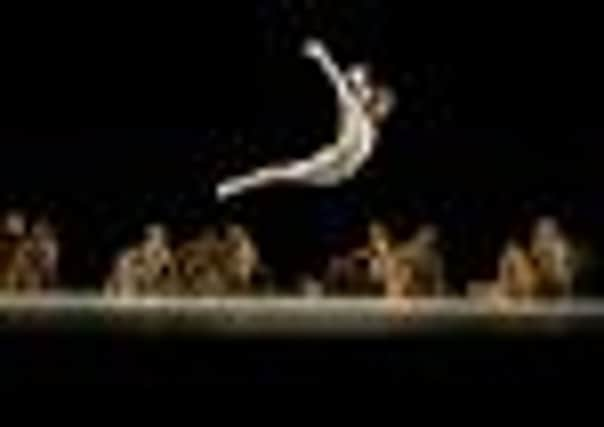Juilliard dance students take to the stage


Jonathan Mills, artistic director of the Edinburgh International Festival, wanted this year’s event to shine a light on upcoming talent, in among the established acts. And the company of dancers, carved from the Juilliard School’s second, third and fourth year students and recent graduates, is the cream of the crop.
Known formerly as a music school, today’s Juilliard gives equal weight to music, dance and drama, and winning a place at the school is a fiercely competitive process, with just 8 per cent of applicants granted a position.
Advertisement
Hide AdAssociate director of the school’s dance division, and a former Juilliard pupil herself, Risa Steinberg has sat on both sides of the audition table. The course itself focuses on both ballet and modern dance, so what do the teachers look for in prospective students?
“People who already have a clear understanding of ballet,” says Steinberg. “Not that they are ballet dancers, but that there is an understanding of alignment, the language of ballet and certain fundamental elements of the movement.”
With partnering such an important aspect of dance, in ballet in particular, they’re also looking for dancers who will work well together, with an even split of 13 men and 13 women admitted each year. Training for, and then working as a dancer takes a certain mindset, so after a rigorous audition process featuring ballet and modern dance classes and solo performances, all the applicants undergo a personal interview.
“Which you would think would be the least important part,” says Steinberg, “but actually is turning out to be significantly important. You never really know for sure, because they’re all at that fabulous age between 17-21 when you change and develop so much, but we do our best to look for talent, potential, capacity and a personality that seems appropriate. We try hard to do what’s best for the student as well as what’s best for the school.”
Many Juilliard alumni have gone on to dance in, set up or run esteemed companies of their own, including the legendary Paul Taylor and Pina Bausch. So the knowledge of who came before them is both inspirational and a little daunting. Added to that is the school’s location.
Based in the Lincoln Center for the Performing Arts in Manhattan, Juilliard shares its home with companies including New York City Ballet, the New York Philharmonic and the Metropolitan Opera. Artistic greatness in many forms is literally on its doorstep. As Steinberg says, however, the school’s prime spot has its good and bad points.
Advertisement
Hide Ad“The fact that we’re in the Lincoln Center gives us lots of opportunities,” she says. “We get lots of tickets for things, and really try to find time for the students to see a lot. And because we’re in Manhattan, companies from around the world come and perform here, so we often have people in to guest teach, or a student in their senior year might be able to go and take company class with them.
“But there are pros and cons to that. To walk out of the Juilliard door and there’s the Metropolitan Opera kicks it up a whole bunch of notches. Which is terrific, but also a bit pressured, in terms of, ‘Can I live up to it all?’”
Advertisement
Hide AdFor the most part, the answer to that question is “yes”. Which is why, although Juilliard is primarily an educational establishment, it can also send its students out into the world to perform.
“There’s always this balance between are we a professional company or are we a school?” says Steinberg. “And it really is something that we have to swim between, which makes it hard in some ways – it would be much easier if we were just a company or just a school. But when they come to Edinburgh, you’ll see that the level of dancer is as if everybody was in a company. It’s extraordinary.”
Part of that sense of professionalism derives from the work they perform. Each year, a challenging and exciting repertoire of pieces is planned for the students, three of which they are bringing to the Festival.
Choreographed almost to the point of completion prior to his death in 1972, José Limón’s The Waldstein Sonata was later re-worked and staged in 1975. Set to Beethoven’s piano sonata of the same name, the music will be performed live by a Juilliard music student.
Spanish choreographer Nacho Duato’s Gnawa is described by Steinberg as “ritualistic and rhythmic, with a humanity that just floods through it and a heat that you can’t escape”. But perhaps most interesting for Scottish audiences, will be the European premiere of Episode 31 by Swedish choreographer Alexander Ekman, a work created specially for the Juilliard dancers.
The last time Ekman’s work was seen in Edinburgh, was when Nederlands Dans Theater 2 (NDT2) performed his hugely entertaining Cacti earlier this year. Given the dancers’ age and prestige, comparisons between Juilliard Dance and NDT2 are inevitable. But according to Steinberg, those comparisons are well founded, with Juilliard “feeding NDT2 at least a dancer or two each year – it’s definitely one of the companies that the students hope to get into”.
Advertisement
Hide AdEasily the most popular international dance company to visit Scotland, NDT2 is loved for all the same reasons we’re bound to love Juilliard.
“There’s a youthful energy to the Juilliard dancers that is led and driven by an extraordinary physical facility,” says Steinberg. “But it’s not as if you just see that physical ability without any intention or emotion behind it. They are young, hungry, for the most part beautiful, specimens that are athletic and passionate.”
l Juilliard Dance is at the Edinburgh Playhouse tonight until 27 August, 8pm. www.eif.co.uk/juilliard